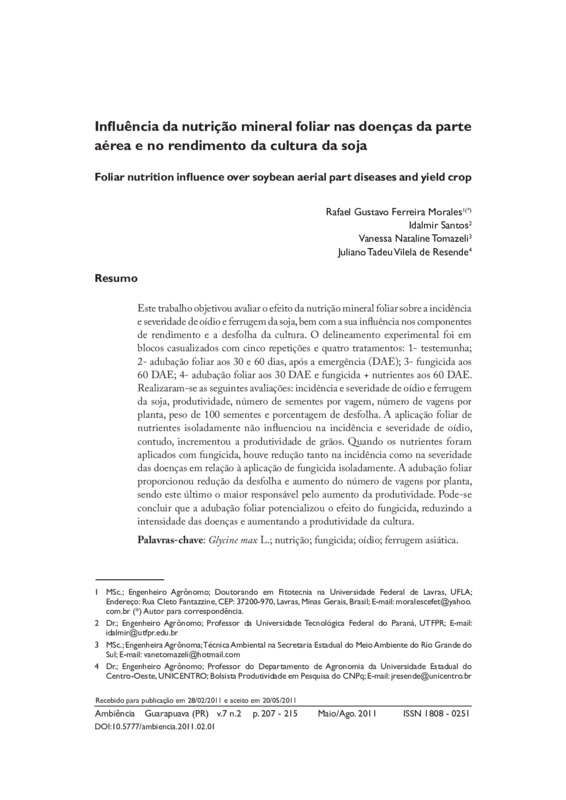Influência da nutrição mineral foliar nas doenças da parte aérea e no rendimento da cultura da soja Foliar nutrition influence over soybean aerial part diseases and yield crop
Item
-
Título
-
Influência da nutrição mineral foliar nas doenças da parte aérea e no rendimento da cultura da soja Foliar nutrition influence over soybean aerial part diseases and yield crop
-
AMBIÊNCIA
-
UFLA
-
UTFPR
-
Description
-
Secretaria Estadual do Meio Ambiente do Rio Grande do Sul
-
Autor
-
Rafael Gustavo Ferreira Morales
-
Idalmir Santos
-
Vanessa Nataline Tomazeli
-
Juliano Tadeu Vilela de Resende
-
Assunto
-
Glycine max L.
-
ferrugem asiática.
-
fungicida
-
nutrição
-
oídio
-
Abstract
-
Este trabalho objetivou avaliar o efeito da nutrição mineral foliar sobre a incidência e severidade de oídio e ferrugem da soja, bem com a sua influência nos componentes de rendimento e a desfolha da cultura. O delineamento experimental foi em blocos casualizados com cinco repetições e quatro tratamentos: 1- testemunha; 2- adubação foliar aos 30 e 60 dias, após a emergência (DAE); 3- fungicida aos 60 DAE; 4- adubação foliar aos 30 DAE e fungicida + nutrientes aos 60 DAE. Realizaram-se as seguintes avaliações: incidência e severidade de oídio e ferrugem da soja, produtividade, número de sementes por vagem, número de vagens por planta, peso de 100 sementes e porcentagem de desfolha. A aplicação foliar de nutrientes isoladamente não influenciou na incidência e severidade de oídio, contudo, incrementou a produtividade de grãos. Quando os nutrientes foram aplicados com fungicida, houve redução tanto na incidência como na severidade das doenças em relação à aplicação de fungicida isoladamente. A adubação foliar proporcionou redução da desfolha e aumento do número de vagens por planta, sendo este último o maior responsável pelo aumento da produtividade. Pode-se concluir que a adubação foliar potencializou o efeito do fungicida, reduzindo a intensidade das doenças e aumentando a produtividade da cultura. AbstractFungicide application is the main form of soybean crop disease control. However, other measures should be adopted as part of control strategy, such as for example, resistance induction by means of plant mineral nutrition. Therefore, this work aimed to evaluate foliar mineral nutrition effects on incidence and severity of soybean oidium and rust, as well as its influence over yield compounds and culture defoliation. Experimental delineation was in randomized blocks design with five replications and four treatments: 1- witness; 2- foliar fertilization at 30 and 60 days after emergence (DAE); 3- fungicide at 60 DAE; 4- fertilization at 30 DAE and fungicide + nutrients at 60 DAE. Following evaluations were made: soybean oidium and rust incidence and severity, yield, number of seed per pod, number of pod per plant, weight of 100 seeds and defoliation percentage. Isolate foliar nutrient application did not influence oidium incidence and severity in the two evaluation periods, however, it has increased grain productivity. When nutrients were applied with fungicide, there was reduction as much in incidence as in the severity of the diseases in relation to the isolate application of fungicide. Foliar fertilization has proportioned defoliation reduction and increased in number of pod per plant, being this last one the most responsible for increasing productivity. It is possible to conclude that foliar fertilization potentiated fungicide effect, reducing disease intensity and enhancing yield culture.
-
volume
-
7
-
issue
-
2
-
Páginas
-
207-215
-
Date
-
2011
-
título curto
-
UNICENTRO
-
Língua
-
pt
-
issn
-
2175-9405
-
Rights
-
Direitos autorais


